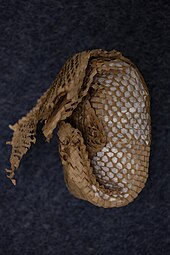Expanded metal
Expanded metal is a material with openings in the surface; these are created by staggered cuts without loss of material while stretching at the same time. The resulting meshes of the lattice-like material made from panels or ribbons are neither braided nor welded. The following mesh shapes are known: diamond mesh, long web mesh, hexagonal mesh, round mesh, square mesh, special mesh.
Expanded metal is also referred to as expanded metal known. Expanded metal can also be made of plastic or other materials, but is usually a metal product.
properties
With expanded metals produced today, the mesh length can be less than 1 mm, the largest meshes are up to 400 mm long. The area proportion of the openings in the total area is between 4 and about 90 percent.
Four sizes are used to describe an expanded metal: mesh length, mesh width, web width and web thickness. The designation 62 × 23-7 × 3 means, for example, mesh length 62 mm, mesh width 23 mm, web width 7 mm, web thickness 3 mm. Mesh length and width are not measured within an opening, but rather from the middle of the knot to the middle of the knot (see DIN 791).
Expanded metal grids achieve considerable strength and surface stability, since metals usually become brittle through stretching ("cold stretching"), i.e. they become more resistant to bending.
In normal production, expanded metal has a corrugated, plastically structured surface. But it is also possible to roll the grid flat so that it is flat like a perforated sheet , for example .
Manufacturing
Sheet metal is used as the starting material, for example sheet steel in thicknesses of 1 to 5 mm, according to more recent books of tables. According to Meyers Konversationslexikon, sheet iron with a thickness of 0.6 to 7 mm was used over 100 years ago , along with sheets of copper, brass and aluminum.
With each punching stroke, the knives are offset by half a stitch. Meyer's Konversationslexikon (1899–1900) states that it was not the knife but the sheet metal that was moved back then.
The width of the sheet metal strip remains unchanged during processing. The webs are stretched during the punching cut, since the sheet metal, which has not yet been punched, resists deformation. However, the length and thus the area increases by two to twelve times. In contrast to perforated sheet metal, there is no waste due to the cut punching.
use
More than 100 years ago, the use as a plaster base ("plastering sheet") was the most widespread in construction . Many of the applications listed below were also known. Expanded metal was used in the GDR border barriers until 1989 .
Expanded metal is used today, for example, as:
- Plaster base in construction (see also Rabitz )
- Cladding of ceilings, walls, railings and facades
- Corner protection rails
- Production of construction joints in reinforced concrete construction
- Support grid in composite materials for the transmission of shear forces with low weight
- fence
- Composter
- Sieve , e.g. B. compost sieve
- Grid in starter batteries, e.g. B. for motor vehicles
- Grease filters , e.g. B. Fume extractor grease filter
- Furniture , e.g. B. ironing board, chair, wastebasket
- Stent in medicine (see picture)
- Testing of luminaires for resistance to dust, solid bodies and water (according to IEC 60598-1 § 9.2)
Expanded metal mesh made from other materials
There is filler for packaging that is punched out of corrugated cardboard scraps in exactly the same shape . The inherently stiff corrugated cardboard becomes full and malleable with a low volume weight and fills cavities or cushions the contents of shipping boxes.
Garlands for decorative purposes are made according to a similar principle . Here the material is paper , which is stretched and creates a voluminous decoration.
If a defect that is larger than the graft needs to be covered in a skin graft , the graft is provided with a knife roller with a diamond-shaped cutting pattern and stretched.
Individual evidence
- ↑ Meyers Konversationslexikon, annual supplement 1899–1900, volume 20, keyword: sheet metal grid (expanded metal )






